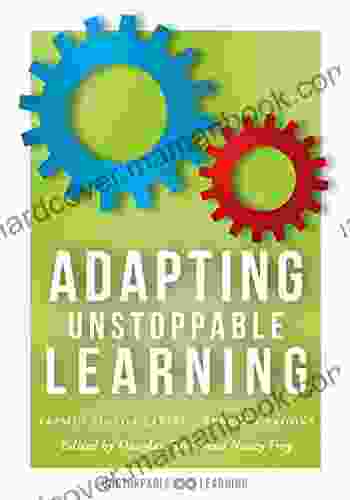How to Differentiate Instruction to Improve Student Success at All Learning Levels

: Embracing Diversity in the Classroom
The modern classroom is a vibrant tapestry of diverse learners, each with their own unique strengths, interests, and learning styles. As educators, we are faced with the daunting task of meeting the needs of every student while ensuring that they all have an equal opportunity to succeed. Differentiated instruction emerges as a beacon of hope, illuminating the path towards personalized learning that unlocks the potential of every student.
4.3 out of 5
| Language | : | English |
| File size | : | 3012 KB |
| Text-to-Speech | : | Enabled |
| Screen Reader | : | Supported |
| Enhanced typesetting | : | Enabled |
| Word Wise | : | Enabled |
| Print length | : | 86 pages |
The Guiding Principles of Differentiated Instruction
- Student-Centered Approach: Differentiated instruction places the student at the heart of the learning process. Educators become facilitators, tailoring instruction to the individual needs, interests, and readiness levels of each learner.
- Flexible Curriculum: The traditional one-size-fits-all curriculum is discarded in favor of a flexible framework that allows educators to modify content, processes, products, and the learning environment to meet the diverse needs of students.
- Assessment for Learning: Assessment becomes an integral part of the teaching and learning process, providing educators with ongoing feedback on student progress, allowing them to adjust instruction accordingly.
Strategies for Implementing Differentiated Instruction
Implementing differentiated instruction requires a shift in mindset and a repertoire of effective strategies. Here are some practical approaches educators can employ:
Content Differentiation
- Tiered Assignments: Create assignments with varying levels of difficulty and complexity to cater to different student readiness levels.
- Choice Boards: Offer students a menu of learning activities to choose from, allowing them to select tasks that align with their interests and learning styles.
Process Differentiation
- Flexible Grouping: Group students based on their learning needs and interests, providing targeted support and challenges.
- Learning Stations: Establish designated areas in the classroom for different learning activities, giving students the opportunity to explore and learn at their own pace.
Product Differentiation
- Alternative Assessments: Provide students with multiple assessment formats, such as essays, projects, presentations, and portfolios, to showcase their learning.
- Personalized Feedback: Offer specific and tailored feedback to each student, addressing their individual strengths and areas for improvement.
Learning Environment Differentiation
- Flexible Seating: Provide students with a variety of seating options to suit their learning preferences and physical needs.
- Sensory Integration: Incorporate sensory elements into the learning environment, such as fidget toys, calming music, and nature-inspired décor, to support students with sensory sensitivities.
Benefits of Differentiated Instruction
Embracing differentiated instruction yields a myriad of benefits for students, educators, and the learning environment as a whole:
For Students:
- Increased Engagement: Tailored instruction captivates students by catering to their interests, learning styles, and readiness levels.
- Improved Academic Achievement: By addressing individual needs, differentiated instruction accelerates student learning and promotes higher levels of academic success.
- Increased Motivation: Students are more motivated to learn when they can actively participate in the design of their learning experiences.
For Educators:
- Enhanced Classroom Management: Differentiated instruction reduces disruptive behaviors by providing students with appropriate challenges and support.
- Increased Job Satisfaction: Educators find greater fulfillment in teaching when they can make a meaningful difference in the lives of all students.
- Professional Development: Implementing differentiated instruction requires ongoing reflection and professional development, fostering educator growth.
For the Learning Environment:
- Inclusive Classrooms: Differentiated instruction creates an inclusive learning environment where all students feel valued and respected.
- Collaborative Learning: Students learn from and with each other, fostering a sense of community and mutual support.
- Positive School Culture: Classrooms that embrace differentiated instruction contribute to a positive and supportive school culture where all students thrive.
: Unlocking the Power of Every Learner
Differentiated instruction is not merely a teaching method; it is a transformative philosophy that empowers educators to unleash the potential of every learner. By embracing the principles, strategies, and benefits of differentiated instruction, we can create classrooms where all students feel valued, engaged, and empowered to succeed. As we continue to evolve our educational practices, differentiated instruction stands as a beacon of hope, illuminating the path towards a more equitable and effective learning experience for all.
May our classrooms be places where diversity is celebrated, where every student discovers their unique strengths, and where the pursuit of knowledge becomes a joyful and fulfilling journey.
Image credits:
- Image by JESHOOTS.com on Unsplash
- Image by Kelly Sikkema on Unsplash
- Image by Josh Boot on Unsplash
4.3 out of 5
| Language | : | English |
| File size | : | 3012 KB |
| Text-to-Speech | : | Enabled |
| Screen Reader | : | Supported |
| Enhanced typesetting | : | Enabled |
| Word Wise | : | Enabled |
| Print length | : | 86 pages |
Do you want to contribute by writing guest posts on this blog?
Please contact us and send us a resume of previous articles that you have written.
 Top Book
Top Book Novel
Novel Fiction
Fiction Nonfiction
Nonfiction Literature
Literature Paperback
Paperback Hardcover
Hardcover E-book
E-book Audiobook
Audiobook Bestseller
Bestseller Classic
Classic Mystery
Mystery Thriller
Thriller Romance
Romance Fantasy
Fantasy Science Fiction
Science Fiction Biography
Biography Memoir
Memoir Autobiography
Autobiography Poetry
Poetry Drama
Drama Historical Fiction
Historical Fiction Self-help
Self-help Young Adult
Young Adult Childrens Books
Childrens Books Graphic Novel
Graphic Novel Anthology
Anthology Series
Series Encyclopedia
Encyclopedia Reference
Reference Guidebook
Guidebook Textbook
Textbook Workbook
Workbook Journal
Journal Diary
Diary Manuscript
Manuscript Folio
Folio Pulp Fiction
Pulp Fiction Short Stories
Short Stories Fairy Tales
Fairy Tales Fables
Fables Mythology
Mythology Philosophy
Philosophy Religion
Religion Spirituality
Spirituality Essays
Essays Critique
Critique Commentary
Commentary Glossary
Glossary Bibliography
Bibliography Index
Index Table of Contents
Table of Contents Preface
Preface Introduction
Introduction Foreword
Foreword Afterword
Afterword Appendices
Appendices Annotations
Annotations Footnotes
Footnotes Epilogue
Epilogue Prologue
Prologue Christof Weber
Christof Weber Camila Hurst
Camila Hurst Nicola Aliani
Nicola Aliani Dianne Chapman Mccleery
Dianne Chapman Mccleery Nl Herzenberg
Nl Herzenberg Lee Sheldon
Lee Sheldon Lazaros Blank Books
Lazaros Blank Books Noam Chomsky
Noam Chomsky Marie Wilkens
Marie Wilkens Bobbi Conner
Bobbi Conner Heide Goody
Heide Goody Kathrine Mortimore
Kathrine Mortimore Natalie Solomon
Natalie Solomon Ellery Akers
Ellery Akers Cedric Kelly
Cedric Kelly Jason Lucas
Jason Lucas Sage Kafsky
Sage Kafsky Les Dale
Les Dale Dan Hampton
Dan Hampton Sierra Demulder
Sierra Demulder
Light bulbAdvertise smarter! Our strategic ad space ensures maximum exposure. Reserve your spot today!

 Christopher WoodsThe Perfect Choice Test Kitchen: Recipes to Unlock the Secrets of Your...
Christopher WoodsThe Perfect Choice Test Kitchen: Recipes to Unlock the Secrets of Your... Ralph TurnerFollow ·13k
Ralph TurnerFollow ·13k Tom ClancyFollow ·11.5k
Tom ClancyFollow ·11.5k Gabriel HayesFollow ·3.5k
Gabriel HayesFollow ·3.5k Cooper BellFollow ·18k
Cooper BellFollow ·18k Jake CarterFollow ·15.1k
Jake CarterFollow ·15.1k Galen PowellFollow ·4.5k
Galen PowellFollow ·4.5k Jarrett BlairFollow ·3.5k
Jarrett BlairFollow ·3.5k Gage HayesFollow ·6.5k
Gage HayesFollow ·6.5k

 Eugene Powell
Eugene PowellComplete Guide to Using Yoga With Kids: Benefits, Tips,...
Yoga is an ancient practice that has been...

 Benji Powell
Benji PowellHow to Make $000 Per Week on Craigslist
Are you looking for a way to make extra money...

 Gabriel Garcia Marquez
Gabriel Garcia MarquezGrocery Row Gardening: The Exciting New Permaculture...
Kick-start your gardening journey with the...

 Hayden Mitchell
Hayden MitchellUnveiling the Gripping World of Winterwood: Ben Hood...
In the annals of crime thrillers, the...

 E.M. Forster
E.M. ForsterThe Financial Advisor Guide To Managing and Investing...
As a financial...

 Lee Simmons
Lee SimmonsIn My Shoes Memoir: A Poignant Journey of Resilience,...
In the tapestry of life, adversity often...
4.3 out of 5
| Language | : | English |
| File size | : | 3012 KB |
| Text-to-Speech | : | Enabled |
| Screen Reader | : | Supported |
| Enhanced typesetting | : | Enabled |
| Word Wise | : | Enabled |
| Print length | : | 86 pages |









